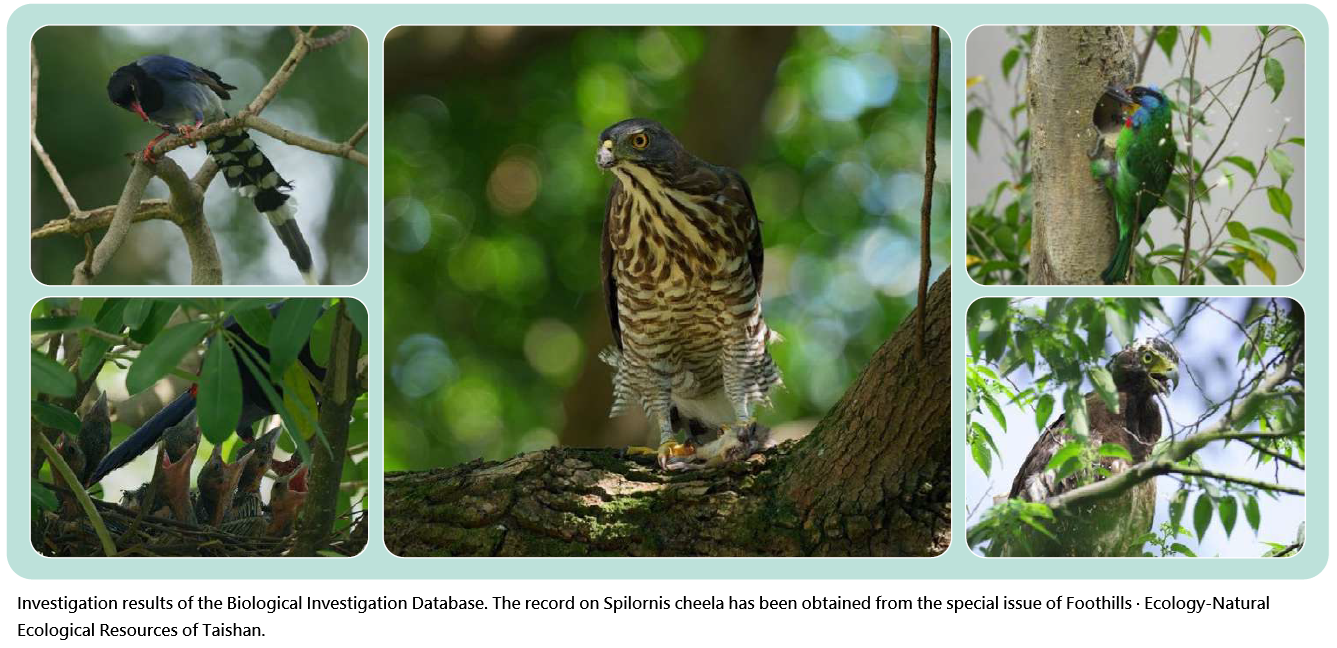Biodiversity
MCUT prioritizes biodiversity conservation. The Fifteenth Meeting of the Conference of the Parties to the Convention on Biological Diversity (COP15) in 2022 led to the adoption of the Kumming-Montréal Global Biodiversity Framework. A key component of this framework is the "30 X 30" goal, which aims to effectively protect and manage 30% of the world's lands and oceans with biodiversity by 2030. MCUT is committed to understanding and implementing the Kumming-Montréal Global Biodiversity Framework. In alignment with this framework, MCUT will gradually increase financial support to enhance biodiversity conservation efforts.
Inventory of Biodiversity Hotspots around the Campus
MCUT is located at the foothills of Guizi Village in the Taishan District of New Taipei City, covering an area of 0.62 km². It has conducted an inventory of biodiversity hotspots within its operational scope using the LEAP (Locate, Evaluate, Assess, Prepare) method to identify natural risks. Additionally, MCUT has adopted the Species Emergence Record Query established by the Taiwan Biodiversity Information Alliance (TBIA) to investigate the emergence records of conservation species around the campus. Initially, the survey was conducted based on relevant data from the Biological Investigation Database established by the Forestry and Nature Conservation Agency, MOA. MCUT is 1.75 km and 2.88 km away from the Xinzhuang Water Conservation Forest (green part), the nearest shelter forest, and Taoyuan's Reservoir and Canal Wetland (blue part), a national wetland, respectively. As a university research organization, MCUT does not impose any direct impact on the biodiversity of these two locations. We will continuously monitor our potential impact on the biodiversity hotspots in these areas and establish relevant management strategies to address biodiversity, thus contributing to the campus's ecological richness.
Additionally, according to relevant data from the "Species Emergence Record Query" established by the Taiwan Biodiversity Information Alliance (TBIA), there were records of the emergence of seven conservation species within a 2 km radius around MCUT (latitude/longitude: 121.42239725449349, 25.041228287119147) in 2024. These species are Zhangixalus taipeianu, Acridotheres cristatellus, Milvus migrans, Otus lettia, Urocissa caerulea, Lanius cristatus, and Spilornis cheela. Among them, a total of 42 bird species, including Spilornis cheela, Otus lettia, and Urocissa caerulea, were active on campus and were recorded in the special issue of Foothills · Ecology-Natural Ecological Resources of Taishan. MCUT will continue to track records on the emergence of conservation species around the campus and will plan and formulate relevant policies to sustain biodiversity.
Blue Magpie Family and Crested Goshawk
According to relevant tracking surveys, a flock of Taiwan Blue Magpies and a mature female Crested Goshawk have been competing for core habitats on campus. This competition arises from the area's native mixed planting forest structure and the availability of living food sources, creating an ecological environment with similar attributes that support both species. At the beginning of 2024, the members of the Taiwan Blue Magpie family worked cooperatively with strong combat skills and successfully reclaimed this area. In April, they built nests in the tree canopy near the edges of the branches of alstonia scholaris and successfully passed through the breeding season. Furthermore, they raised seven new members, with some of them remaining within the original family.
Safety Monitoring of Side Slopes and School Buildings on Campus
Due to the campus being situated on hilly land and with some school buildings located in debris flow hazard zones, MCUT has been actively working with the Taishan District Office in New Taipei City to coordinate the "Mudslide Prevention Education and Shelter Promotion" activities. Additionally, a safety monitoring system has been established on the slopes and school buildings within the campus to continuously assess the stability of the slopes, monitor any displacement or inclination of the school buildings, and collect relevant data to ensure the safety of teachers and students. This initiative aims to foster a strong understanding of disaster prevention and safeguard the lives and property of the school community.
Seismic Safety Monitoring and Early-Warning System for School Building
The earthquake early warning system utilizes primary waves, secondary waves, and surface waves generated by earthquakes, in conjunction with electronic communication technology. It reads and analyzes real-time transmission data from campus buildings along with earthquake notification records from the Meteorological Bureau to quickly assess the safety of campus structures. If the seismic intensity measured by the seismometer reaches or exceeds 0.8 gal, a text message is sent to alert the university’s level 1 supervisor, providing details on the seismic intensity and building safety evaluation. From May 13, 2023, to May 12, 2024, a total of 118 earthquake events were reported, with seismic intensities ranging from 0 to 4. The most significant event occurred on April 3, 2024, in eastern Hualien. The epicenter was located in Shoufeng Township, Hualien County, Taiwan, with a magnitude of 7.1 on the Richter scale and a focal depth of 19.7 kilometers. The intensity recorded in New Taipei City was a weak level 5.
The earthquake monitoring system at MCUT detected the intensity of this earthquake as level 4. The maximum overall structural performance of buildings was assessed as level 1. Additionally, when secondary tremors were monitored by the system, the frequency for Student Dormitory 3 was 347 Hz. The overall assessment indicated that there was no threat to the safety of campus buildings.
Given our proximity to the fault line that runs through New Taipei City and Taipei City, we conduct regular disaster prevention drills to ensure the safety of teachers, students, and employees. These drills, including evacuation exercises, are organized to enhance the awareness of teachers and students in order to reduce casualties.




